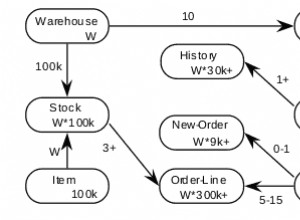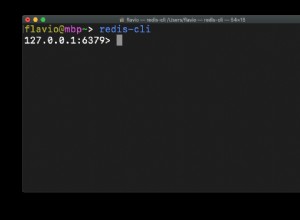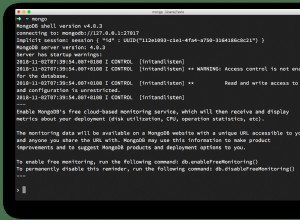En MongoDB, el $orderBy modificador de consulta ordena los resultados de una consulta en orden ascendente o descendente.
$orderBy acepta un documento que especifica el campo a ordenar y el orden de clasificación. El orden de clasificación puede ser 1 para ascender o -1 por descender.
$orderBy ha quedado en desuso en el mongo cáscara desde v3.2. Usa el cursor.sort() en su lugar.
Datos de muestra
Supongamos que tenemos una colección llamada pets con los siguientes documentos:
{ "_id" : 1, "name" : "Wag", "type" : "Dog", "weight" : 20 }
{ "_id" : 2, "name" : "Bark", "type" : "Dog", "weight" : 10 }
{ "_id" : 3, "name" : "Meow", "type" : "Cat", "weight" : 7 }
{ "_id" : 4, "name" : "Scratch", "type" : "Cat", "weight" : 8 }
{ "_id" : 5, "name" : "Bruce", "type" : "Kangaroo", "weight" : 100 }
{ "_id" : 6, "name" : "Hop", "type" : "Kangaroo", "weight" : 130 }
{ "_id" : 7, "name" : "Punch", "type" : "Kangaroo", "weight" : 200 }
{ "_id" : 8, "name" : "Snap", "type" : "Cat", "weight" : 12 }
{ "_id" : 9, "name" : "Ruff", "type" : "Dog", "weight" : 30 } Ordenar en orden ascendente
Para ordenar en orden ascendente, usamos 1 para el orden de clasificación.
A continuación se muestra un ejemplo de una consulta que utiliza $orderBy modificador de consulta para ordenar esa colección por el weight campo en orden ascendente.
db.pets.find( { $query: {}, $orderBy: { weight: 1 } } )Resultado:
{ "_id" : 3, "name" : "Meow", "type" : "Cat", "weight" : 7 }
{ "_id" : 4, "name" : "Scratch", "type" : "Cat", "weight" : 8 }
{ "_id" : 2, "name" : "Bark", "type" : "Dog", "weight" : 10 }
{ "_id" : 8, "name" : "Snap", "type" : "Cat", "weight" : 12 }
{ "_id" : 1, "name" : "Wag", "type" : "Dog", "weight" : 20 }
{ "_id" : 9, "name" : "Ruff", "type" : "Dog", "weight" : 30 }
{ "_id" : 5, "name" : "Bruce", "type" : "Kangaroo", "weight" : 100 }
{ "_id" : 6, "name" : "Hop", "type" : "Kangaroo", "weight" : 130 }
{ "_id" : 7, "name" : "Punch", "type" : "Kangaroo", "weight" : 200 } Ordenar en orden descendente
Para ordenar en orden descendente, usamos -1 para el orden de clasificación.
db.pets.find( { $query: {}, $orderBy: { weight: -1 } } )Resultado:
{ "_id" : 7, "name" : "Punch", "type" : "Kangaroo", "weight" : 200 }
{ "_id" : 6, "name" : "Hop", "type" : "Kangaroo", "weight" : 130 }
{ "_id" : 5, "name" : "Bruce", "type" : "Kangaroo", "weight" : 100 }
{ "_id" : 9, "name" : "Ruff", "type" : "Dog", "weight" : 30 }
{ "_id" : 1, "name" : "Wag", "type" : "Dog", "weight" : 20 }
{ "_id" : 8, "name" : "Snap", "type" : "Cat", "weight" : 12 }
{ "_id" : 2, "name" : "Bark", "type" : "Dog", "weight" : 10 }
{ "_id" : 4, "name" : "Scratch", "type" : "Cat", "weight" : 8 }
{ "_id" : 3, "name" : "Meow", "type" : "Cat", "weight" : 7 } Una forma alternativa
El $orderBy el modificador de consulta también se puede utilizar con el siguiente formulario:
db.pets.find()._addSpecial( "$orderby", { weight : 1 } )Más información
Como se mencionó, el $orderBy el modificador de consulta ha quedado obsoleto en mongo cáscara desde v3.2. Usa el cursor.sort() en su lugar.
Consulte la documentación de MongoDB para obtener más información.




